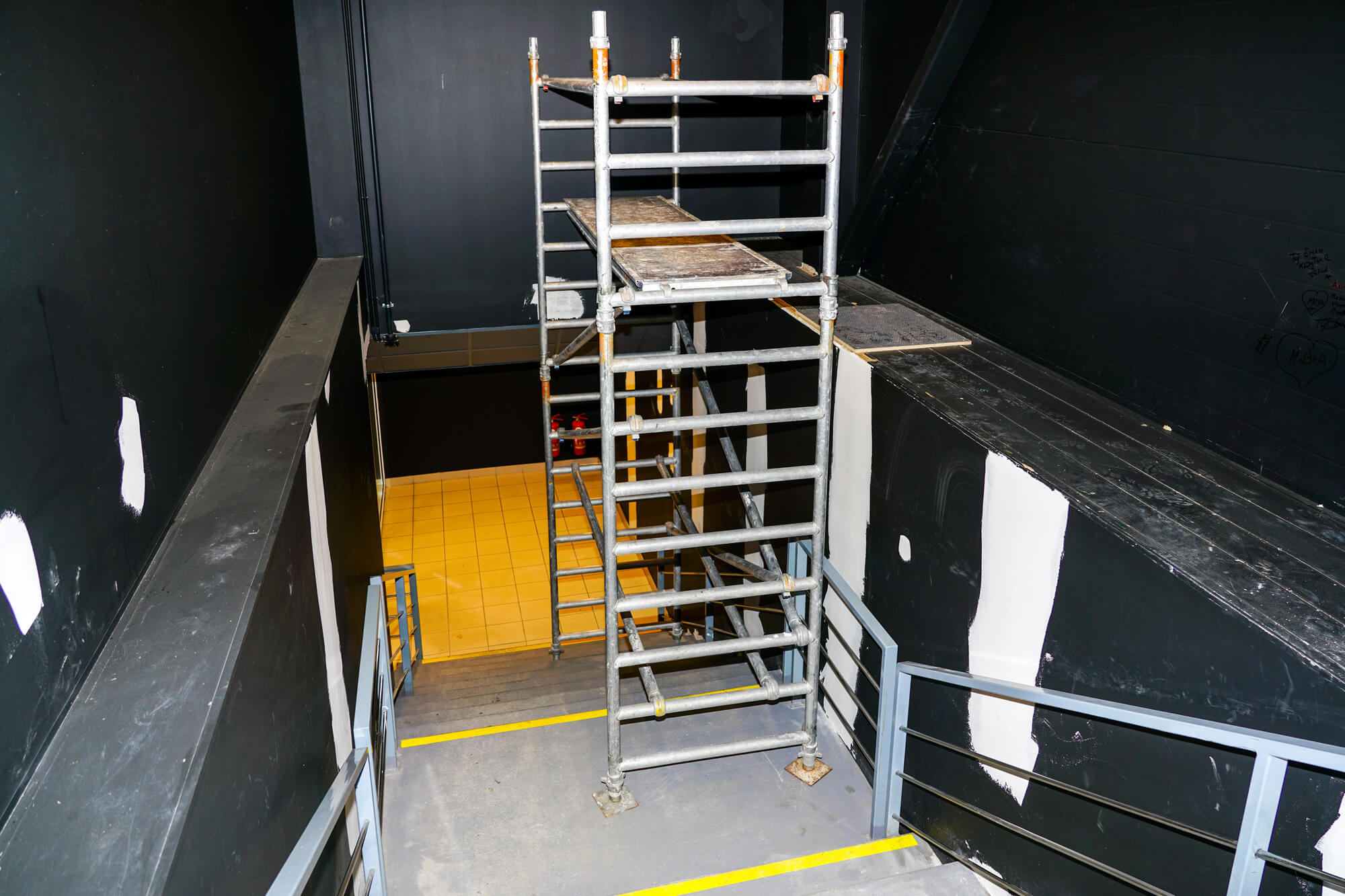

Articles
What Can I Use Instead Of A Ladder
Modified: January 5, 2024
Looking for alternatives to using a ladder? Check out our informative articles on safe and efficient options to help you reach new heights.
(Many of the links in this article redirect to a specific reviewed product. Your purchase of these products through affiliate links helps to generate commission for Storables.com, at no extra cost. Learn more)
Introduction
When it comes to reaching high places or performing tasks that require elevation, a ladder is often the go-to tool. However, there may be situations where using a ladder is not the most practical or safe option. Whether it’s due to space constraints, weight limitations, or personal preference, it’s important to explore alternative solutions that can provide the same level of functionality without compromising safety or effectiveness.
In this article, we will explore several alternatives to using a ladder and discuss their advantages and drawbacks. From step stools to aerial lifts, there are various options available depending on the specific task at hand. By understanding these alternatives, you can make an informed decision and choose the best tool for the job.
Key Takeaways:
- Step stools and extension poles offer portable and maneuverable alternatives to ladders for low-level tasks, providing stability and ease of use in confined spaces.
- Scaffolding systems and aerial lifts provide larger working surfaces and enhanced safety features for extensive projects and significant heights, prioritizing stability and efficiency.
Read more: What Can I Use Instead Of Curtains
Step Stools
When the height you need to reach is relatively low, a step stool can be a convenient and safer alternative to using a ladder. Step stools are lightweight and compact, making them easy to store and transport. They typically have a few steps, providing a stable platform for you to stand on while working.
Step stools are commonly used in households for tasks like changing light bulbs, cleaning high shelves, or accessing upper cabinets. They are also popular in offices, classrooms, and retail settings. Many step stools now come with built-in features for added convenience, such as foldable designs, non-slip surfaces, and handrails for enhanced stability.
One of the main advantages of using a step stool is that it allows for easy maneuverability in tight spaces. Unlike ladders, step stools are generally more compact and have a smaller footprint. This can be especially beneficial when working in confined areas or navigating through narrow doorways.
However, it’s important to note that step stools have their limitations. They are typically designed for low-level tasks and are not suitable for reaching heights beyond a few feet. If you need to access higher areas or perform prolonged work at elevation, it’s advisable to consider other alternatives, such as scaffolding systems or aerial lifts.
In summary, step stools are a practical and portable option for tasks that require minimal height reach. They offer stability, maneuverability, and ease of use, making them ideal for various applications. However, it’s essential to assess your specific needs and the height requirements of your task to determine if a step stool is the right choice or if another alternative would be more appropriate.
Scaffolding Systems
When it comes to working at greater heights or completing more extensive projects, scaffolding systems can be a versatile alternative to using a ladder. Scaffolding consists of a series of platforms, bars, and supports that can be assembled to create a stable and secure elevated work area.
One of the main advantages of using scaffolding systems is their ability to provide a larger and wider working surface compared to ladders. This allows for greater mobility, increased stability, and the ability to work with tools and materials more comfortably. Scaffolding systems also offer added safety features, such as guardrails and toe boards, which help prevent accidental falls.
Scaffolding systems come in various types and configurations, including mobile scaffolds, tower scaffolds, and suspended scaffolds. Mobile scaffolds are equipped with wheels, making them easy to move around and reposition. Tower scaffolds are suitable for tasks that require working at greater heights, as they offer increased stability and additional levels.
Suspended scaffolds, also known as swing stages, are commonly used in construction and maintenance projects that involve working on the exterior of tall buildings. These platforms are suspended by ropes or cables and can be adjusted to different heights as needed.
While scaffolding systems provide many advantages, it’s important to consider potential drawbacks as well. Scaffolding can be time-consuming to set up and dismantle compared to ladders, requiring proper assembly and adherence to safety guidelines. Additionally, scaffolding systems may require additional training or certifications for safe operation.
In summary, scaffolding systems offer a safe and efficient alternative to ladders when working at greater heights or on more extensive projects. They provide a larger working surface, enhanced stability, and additional safety features. However, due to their complexity and potential setup requirements, it’s essential to assess the specific needs of your project and ensure proper training and safety precautions are in place.
Extension Poles
Extension poles are a versatile tool that can be used as an alternative to ladders for tasks that require reaching high places. They consist of a telescoping pole with an attachment at the end, allowing you to access elevated areas without the need for a ladder.
One of the primary benefits of using extension poles is their ability to extend your reach without the need to physically climb up a ladder. They are commonly used for tasks such as painting ceilings, cleaning windows, and changing light bulbs. Extension poles are lightweight, portable, and easy to maneuver, making them a convenient option.
Extension poles are available in various lengths, allowing you to choose the appropriate size depending on the height you need to reach. They are typically adjustable, meaning you can extend or retract the pole to achieve the desired length. Some extension poles also come with interchangeable attachments, such as brushes, rollers, or dusters, further enhancing their versatility.
While extension poles provide a practical alternative to ladders, they do have some limitations. They are most effective for tasks that require minimal physical exertion and do not involve working on unstable or uneven surfaces. Additionally, it’s important to ensure that the attachment at the end of the extension pole is securely attached to prevent accidents or damage.
In summary, extension poles offer a safe and accessible option for reaching high places without the need for a ladder. They are lightweight, portable, and versatile, making them suitable for a wide range of tasks. However, it’s important to consider the specific requirements of your task and ensure proper attachment and stability to ensure safety and effectiveness.
Consider using a sturdy step stool, scaffolding, or an extension pole with attachments for reaching high areas instead of a ladder. Always prioritize safety and stability when working at heights.
Aerial Lifts
When it comes to working at significant heights or performing tasks that require a stable and secure platform, aerial lifts are an excellent alternative to ladders. Aerial lifts, also known as cherry pickers or boom lifts, are mechanical devices equipped with a platform that can be raised and lowered to access elevated areas.
One of the main advantages of using aerial lifts is their ability to provide a large and stable working platform, allowing for increased mobility and the use of tools and equipment. They are commonly used in construction, maintenance, and facility management industries for tasks such as installing signage, trimming trees, and conducting inspections on tall structures.
Aerial lifts come in various forms, including scissor lifts, articulating boom lifts, and telescopic boom lifts. Scissor lifts are versatile and provide vertical elevation, making them suitable for tasks that require working at a fixed height. Articulating boom lifts offer flexibility and maneuverability, as they can reach over and around obstacles. Telescopic boom lifts provide vertical and horizontal reach, making them ideal for accessing areas that are hard to reach.
One of the significant advantages of aerial lifts is their enhanced safety features. Most lifts are equipped with safety harnesses and guardrails to ensure the security of the operator. They also have stabilizing mechanisms to prevent tipping or overturning. However, it’s essential to receive proper training and follow safety protocols when operating an aerial lift to minimize risks.
While aerial lifts offer numerous advantages, they are costly and require more significant planning and preparation compared to ladders or other alternatives. They also have space restrictions and may not be suitable for all environments or surfaces.
In summary, aerial lifts provide a safe and efficient alternative to ladders for tasks that require working at significant heights or in hard-to-reach areas. They offer a large and stable working platform, enhanced safety features, and versatility. However, it’s important to assess the specific requirements of your project and consider the associated costs and safety measures before opting for an aerial lift.
Read more: What Can I Use Instead Of A Protractor
Ladder Alternatives for Specific Situations
While ladders are commonly used for various tasks, there are specific situations where alternative tools or equipment may be more suitable. Here are a few ladder alternatives for specific scenarios:
- Ladder Platforms: Ladder platforms are attachments that can be added to a ladder to provide a stable and secure standing platform. These platforms can be beneficial when working on uneven or unstable surfaces, providing a level platform to stand on while minimizing ladder wobbling.
- Stair Steppers: Stair steppers are specifically designed to navigate staircases and inclines safely. They typically have three or more legs with adjustable heights to ensure stability while ascending or descending stairs. Stair steppers are commonly used for transporting heavy objects up and down stairs, making it easier and safer without the need for a ladder.
- Climbing Harnesses with Rope and Pulley Systems: For tasks that involve working at extreme heights or in challenging environments, such as rock climbing or industrial rope access, using climbing harnesses with rope and pulley systems can be a safer alternative. These systems allow for controlled ascent and descent, providing stability and security, while avoiding the limitations of a ladder.
- Pole Saws: When it comes to trimming trees or cutting branches, a pole saw can be a practical alternative to a ladder. Pole saws consist of a saw blade attached to a long pole, allowing you to reach and cut higher branches without the need to climb up a ladder. They offer increased safety by keeping you on the ground while still allowing you to trim or prune trees effectively.
- Ramps: In situations where you need to move heavy equipment or machinery onto a truck, using ramps can be a safer and more efficient alternative to using a ladder. Ramps provide a gradual incline, allowing for easy loading and unloading without the risk of climbing up and down a ladder while carrying heavy objects.
It’s important to consider the specific requirements of your task and the potential risks involved when choosing a ladder alternative. While these alternatives can be beneficial in many situations, it’s crucial to assess safety measures, training requirements, and any additional equipment needed to ensure a safe and successful outcome.
Conclusion
While ladders are commonly used for accessing heights and completing various tasks, there are situations where alternative tools and equipment may be more suitable. Whether it’s due to space constraints, extensive projects, or specific requirements, having a range of ladder alternatives can provide safer and more efficient solutions.
In this article, we explored several ladder alternatives, including step stools, scaffolding systems, extension poles, aerial lifts, and specialized tools for specific situations. Step stools offer a portable and maneuverable option for low-level tasks, while scaffolding systems provide stability and a larger working surface for more extensive projects.
Extension poles allow for reaching heights without climbing a ladder, and aerial lifts offer a secure and stable platform for working at significant heights. Additionally, specialized tools like ladder platforms, stair steppers, climbing harnesses, pole saws, and ramps provide solutions for specific scenarios.
When deciding on the appropriate ladder alternative, it’s crucial to consider factors such as the height requirements, space limitations, safety features, training needs, and the specific nature of the task at hand. Assessing these factors will help you choose the most suitable alternative that ensures both safety and efficiency.
It’s important to remember that while ladder alternatives can provide viable options, they may not always be feasible or practical for every situation. Each alternative has its own advantages, drawbacks, and specific applications. It’s essential to carefully evaluate your needs and determine the best tool or equipment to meet those needs.
In conclusion, by exploring and understanding ladder alternatives, you can make informed decisions that prioritize safety, efficiency, and effectiveness. Whether you opt for step stools, scaffolding systems, extension poles, aerial lifts, or specialized tools, choosing the right tool for the job ensures a successful outcome and contributes to a safe working environment.
Frequently Asked Questions about What Can I Use Instead Of A Ladder
Was this page helpful?
At Storables.com, we guarantee accurate and reliable information. Our content, validated by Expert Board Contributors, is crafted following stringent Editorial Policies. We're committed to providing you with well-researched, expert-backed insights for all your informational needs.















0 thoughts on “What Can I Use Instead Of A Ladder”